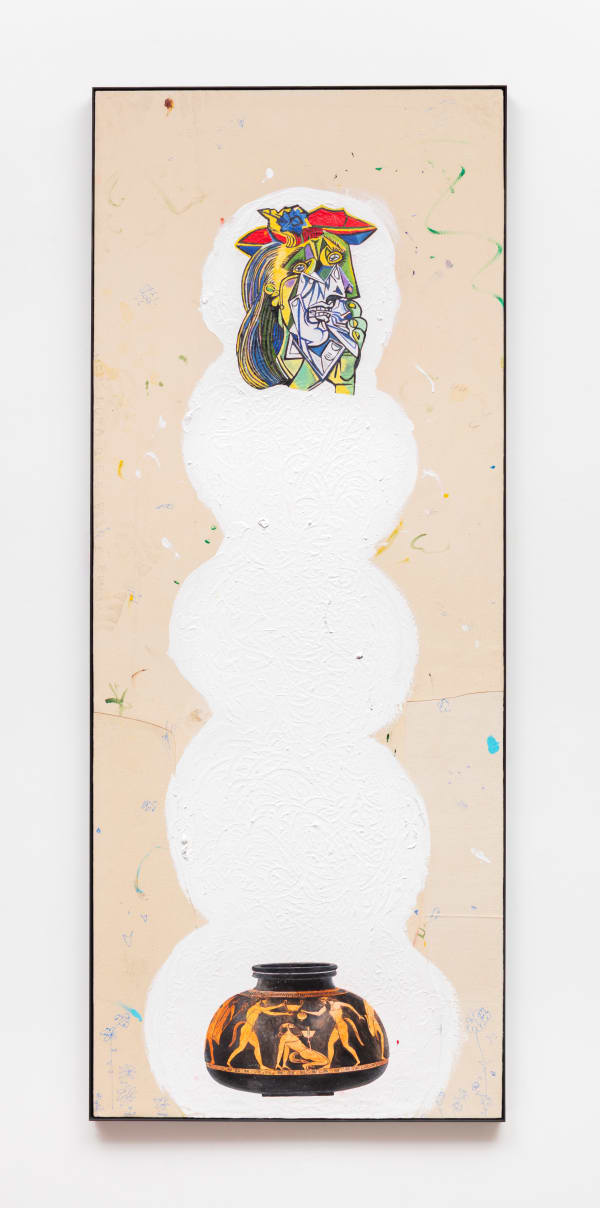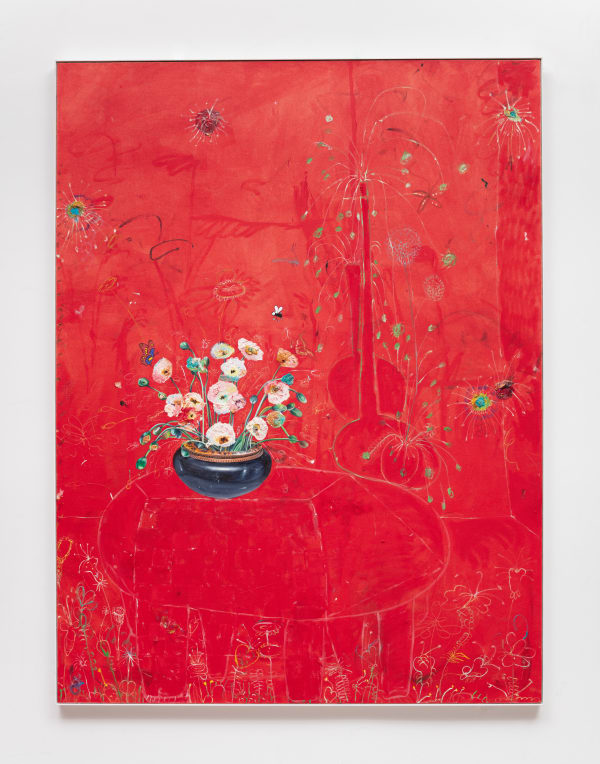Do cômico e do trágico Paulo Nimer Pjota
What are the possible connections between representations of a couple of Buddhist deities, domestic scenes, and the images that decorate both Chinese vases and pre-Columbian objects?
In “Do cômico e do trágico” Paulo Nimer Pjota addresses key aspects in his practice: rearranging symbolic projections from cosmologies of geographically and temporally distant societies; salvaging of centuries of iconographic production; breaking with the hegemonic notion of human history as a linear trajectory and; studying repetition and permanence of mythological narratives shared by different cultures, such as the myth of the double.
When I visited him in his studio in Ipiranga, São Paulo, in March, I saw some of the works that would be part of this new exhibition. Even though some of them were still in their initial stages, it was already possible to see the movements guiding their efforts. On one wall was a group of three paintings stylized as medieval alchemical engravings. In each work, there was a notable representation of a strange bipedal figure, amorphous in body and with the air of a gorgon. It was difficult to state the functionality of the elements that made up those bodies, and maybe upon closer inspection, one would realize that three of them were representations of the Citipati, Buddhist protective deities often portrayed as a binary couple of skulls committed to spending all eternity in a frantic dance associated with the cycles of life and death.
We know that different cultures deal with moments of transition (life - death) over time or disparate human emotions (joy - sadness) as inseparable and complementary. By choosing to represent the duo of entities, Pjota seems to allude to the paradoxical nature of the exhibition title, inviting us to view these works as reflections on the myth of the double and the circularity and recurrence of narratives of this sort between different human contexts. With that in mind, as I looked back at the two larger paintings of the same series, the dismal aspect they initially provoked in me gave way to a more playful feeling, too.
In one of them, positioned in the center, its members support both a pre-Columbian and a Greco-Roman vase, the latter with a small medusa on its surface. In his double, on the right, his members take on the form of a Roman helmet and again of a pre-Columbian vase. In the third painting, the creature rests very close to the corner of the canvas seated and, unlike the previous ones, two objects seem not merely to compose its body but, rather, to be gifts offered to the couple. In terms of composition, the three strange figures stand out due to the contrasts of colors and the painting technique applied. Although none present a vanishing point from a traditional perspective, the artist created a sense of depth by scratching the surface rather than adding more layers of paint on the canvas.
Colheita de flores mágicas is divided into two segments by overlapping materials and colors. On the left, a white metal plate is fixed to the outer edges of the painting while also serving as a background for the sudden appearance of a three-dimensional element, a bronze mask. On the right is another strange bipedal figure, and there is a mask, this time of Guatemalan origin, and a Mycenaean vase. Together, those elements, due to a range of details and colors, denote a different relationship between the creature and the objects and do not seem to compose the piece in the same way we perceived in the previous series. If the grooves present on Mercury were the main tools for creating depth, here they are associated with a set of other vectors in the composition of the canvas.
In Cerimônia com papoula, the difference between the figures and the background is through the textures - while i is more diffuse, in the body of the figure located on the left, Pjota seems to repeat the gesture of the invoice in a denser and more concentrated way. The painting also features two ex-votos, which despite their abundance in the Brazilian artistic-religious context, formal variations of these sculptures, are widely produced from Asia to Europe. The one depicted on the left, with an unusual resemblance to a human skull, is supported on the body of a figure in a more anthropomorphic way than the other paintings. The other, abandoned in the right corner of the canvas, forges with its volume a notion of perspective reinforced by the set of bronze flowers, which accompanies and gives the work its title.
The protagonism of mythical creatures is replaced by domestic situations in works such as Cenas de casa (vaso com dragão), Estúdio vermelho e Estúdio azul. In common, in addition to the blatant reference to still lives, the three present a few tonal variations in their backgrounds. Returning to the idea of the double, Estúdio vermelho and Estúdio azul look like sister works. In each composition, the artist balances two types of formal representations; on the one hand, he paints poppies informed by more with technical prowess, and on the other, pressed against the background, flowers without the same formal aspect share the scene with other household objects.
Finally, Cenas de casa (vaso com dragão) synthesizes the efforts of Pjota's practice - most of its surface is covered by studies, which resemble urban inscriptions and refer to formative years in his trajectory. In the lower half of the canvas, we notice a table where the vase with motifs apparently of Chinese origin rests that baptizes the work. On the edges, we can see several cutouts of tea towels with a floral pattern framing the canvas. Very precisely, the artist combines this series of appropriations, placing his extensive list of references in the same status - he breaks with a historical equation of value, highlighting the fragility of distinctions between artistic categories and insisting on reflection on the collectivity of human cultural productions.
Pjota's works function as time capsules, unfolding stories, praising otherness, and defending the desire for dialogue. By looking at the history of art, symbols, and elements of material culture, in this new group of paintings and sculptures, the artist establishes unconventional dialogues between peoples, times, and locations. This mix not only results in the restoration of broken ties and histories but also reveals connections between the cultural repertoires of human groups dispersed across the globe.
Thiago de Paula Souza
May – 2023














